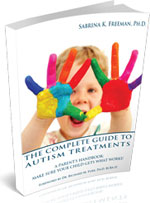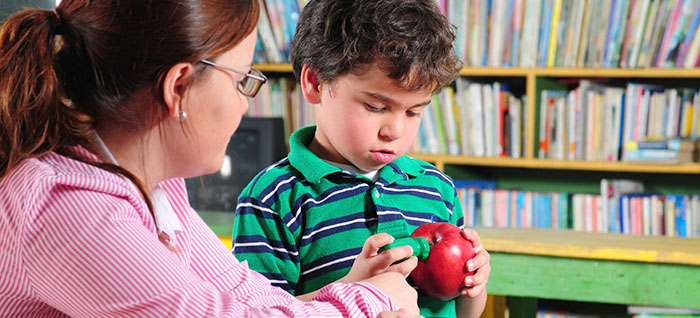 Noncontingent reinforcement (NCR) is the presentation of reinforcement independent of behavior, and there are many studies out there that demonstrate it can have a significant impact on behavior.
Noncontingent reinforcement (NCR) is the presentation of reinforcement independent of behavior, and there are many studies out there that demonstrate it can have a significant impact on behavior.
Before we get to how you can use it with children with autism or other developmental disabilities, it’s important to recognize that noncontingent reinforcement happens all the time with all of us. A few common examples:
- You’re walking alongside your child. Your child reaches up and grabs your hand. This is a behavior you like, but it did not occur because of any one behavior you exhibited, such as reaching for their hand or requesting their hand. They just did it spontaneously. This probably changes your behavior: you may smile, initiate a conversation, or give their hand a special squeeze.
- It’s snack time at your preschool. You realize the bag of popcorn you’re giving for snack is almost empty, so you give each student a few extra kernels of popcorn. They did not “earn” it for good behavior, it was just a little extra reinforcement. This may change your students’ behavior: they may sit still a little longer as they eat the additional snack, say thank you, or exclaim, “More popcorn! Yay!”
- A common example in preschool is placing a child on your lap during story time. They didn’t earn it, but it may change their behavior. For example, instead of calling out to get your attention, they may sit quietly for the duration of the story.
- You’ve come home from a stressful day at work. You want to just sit down and veg in front of the TV for a few minutes, but discover that your husband has cooked dinner. This may change your behavior: you may sit down at the dining room table or give him a hug. Again, you didn’t exhibit a specific behavior that “earned” you dinner; it was presented independent of your behavior.
Noncontingent reinforcement can be a powerful addition to your interventions. But it looks a bit different when you’re using it as part of your intervention. You want to provide continuous access to the reinforcer maintaining the problem behavior so that the problem behavior becomes unnecessary. The preschooler sitting on the teacher’s lap is an excellent example, because the child has continuous access to the teacher’s attention. This can be faded over time, but can be an effective starting point for reducing problem behaviors when used in conjunction with other strategies.
Research has shown that noncontingent attention can decrease destructive behavior, noncontingent juice can decrease rumination, noncontingent access to preferred items can decrease inappropriate mealtime behavior, and noncontingent social interaction can decrease vocal stereotypy (Hanley, Piazza, & Fisher, 1997; Kliebert & Tiger, 2011; Gonzalez, Rubio, & Taylor, 2014; Enloe & Rapp, 2013). There is much more research out there that demonstrates that noncontingent reinforcement can impact behavior. Here are a few tips for using it:
- Make sure it matches the function. If your student is engaging in destructive behavior in order to escape a task, then providing noncontingent attention is unlikely to produce the behavior change you are expecting.
- Decide on a method for providing noncontingent reinforcement. Will you provide it continuously (like the preschooler sitting in the teacher’s lap) or provide it on an interval schedule (such as providing verbal attention every 2 minutes)?
- Take data! You need to know if the noncontingent reinforcement is actually decreasing the problem behavior or increasing the desired behavior. Define the behavior you want to change and then take data on its frequency, rate, or duration.
- Account for other students’ needs. If you are only using noncontingent reinforcement for one student, you need to be prepared to address the needs of other students. For example, if just one preschooler gets to sit in the teacher’s lap every day at story time, you may see an increase in problem behaviors from the other preschoolers in the class.
- Plan ahead! Our ultimate goal is that our learners be as independent as possible. Plan for how to fade your intervention over time.
- Take a look at the research. There are a few studies cited at the end of this article, but you may be able to find research simply by searching for “noncontingent” and the name of your problem behavior.
Noncontingent reinforcement is much easier to implement than many interventions that are available and can have a huge impact on your learner’s behaviors.
References
Enloe, K., & Rapp, J. (2013). Effects of noncontingent social interaction on immediate and subsequent engagement in vocal and motor stereotypy in children with autism. Behavior Modification , 38(3), 374-391.
Gonzalez, M., Rubio, E., & Taylor, T. (2014). Inappropriate mealtime behavior: The effects of noncontingent access to preferred tangibles on responding in functional analyses. Research in Developmental Disabilities , 35(12), 3655-3664.
Hanley, G. P., Piazza, C. C., & Fisher, W. W. (1997). Noncontingent presentation of attention and alternative stimuli in the treatment of attention-maintained destructive behavior. Journal of Applied Behavior Analysis , 30(2), 229-237.
Kliebert, M. L., & Tiger, J. H. (2011). Direct and distal effects of noncontingent juice on rumination exhibitied by a child with autism. Journal of Applied Behavior Analysis , 44(4), 955-959.
WRITTEN BY SAM BLANCO, MSED, BCBA
Sam is an ABA provider for students ages 3-12 in NYC. Working in education for ten years with students with Autism Spectrum Disorders and other developmental delays, Sam has developed strategies for achieving a multitude of academic, behavior, and social goals. Sam is currently pursuing her PhD in Applied Behavior Analysis at Endicott College.
 The Question Challenge Card Game is an expressive and receptive language card game that targets social and reasoning skills in young learners. This game will target skills in staying calm through self-talk, predicting, questioning in conversation, determining perspective, inferencing, cognitive flexibility, intonation, body language, and more. As they play the game, students will practice skills necessary for effective communication and problem solving.
The Question Challenge Card Game is an expressive and receptive language card game that targets social and reasoning skills in young learners. This game will target skills in staying calm through self-talk, predicting, questioning in conversation, determining perspective, inferencing, cognitive flexibility, intonation, body language, and more. As they play the game, students will practice skills necessary for effective communication and problem solving.


 Don’t let picky eating ruin meal time or divide your family at the dinner table. Encouraging healthy eating habits with a stubborn child requires patience with a firm touch. Here at Kutest Kids Early Intervention Center, our therapists are all too familiar with this phenomenon and would like share some common tips. Begin by setting the stage for healthy choices, thereby helping your child overcome their picky habits with a few key strategies.
Don’t let picky eating ruin meal time or divide your family at the dinner table. Encouraging healthy eating habits with a stubborn child requires patience with a firm touch. Here at Kutest Kids Early Intervention Center, our therapists are all too familiar with this phenomenon and would like share some common tips. Begin by setting the stage for healthy choices, thereby helping your child overcome their picky habits with a few key strategies. This week only, use our promo code
This week only, use our promo code 

 Learning that your child has autism is incredibly overwhelming. You’re under intense stress to make the best decisions possible for your child, and to do so quickly. Add to the fact that autism is a popular topic in the news and social media, so tips and quick fixes frequently show up in headlines and news feeds. Autism is considered to be a fad treatment magnet, and while some of the fad treatments are ineffective, others are flat out dangerous. How is it possible to parse through all this to find reliable information? Here are a few tips to help you out:
Learning that your child has autism is incredibly overwhelming. You’re under intense stress to make the best decisions possible for your child, and to do so quickly. Add to the fact that autism is a popular topic in the news and social media, so tips and quick fixes frequently show up in headlines and news feeds. Autism is considered to be a fad treatment magnet, and while some of the fad treatments are ineffective, others are flat out dangerous. How is it possible to parse through all this to find reliable information? Here are a few tips to help you out: So where can you find valid information?
So where can you find valid information?  Noncontingent reinforcement (NCR) is the presentation of reinforcement independent of behavior, and there are many studies out there that demonstrate it can have a significant impact on behavior.
Noncontingent reinforcement (NCR) is the presentation of reinforcement independent of behavior, and there are many studies out there that demonstrate it can have a significant impact on behavior.
 Valentine’s Day Bingo
Valentine’s Day Bingo

 Recently I was working with a family to toilet train their son Jonathan, a six-year-old with autism. (Names and identifying characteristics have been changed to protect confidentiality.) When he eliminated in the toilet, part of his reinforcement was getting to watch the water go down the toilet after flushing. At some point, he developed the behavior of putting his hands into the toilet water as it was flushing.
Recently I was working with a family to toilet train their son Jonathan, a six-year-old with autism. (Names and identifying characteristics have been changed to protect confidentiality.) When he eliminated in the toilet, part of his reinforcement was getting to watch the water go down the toilet after flushing. At some point, he developed the behavior of putting his hands into the toilet water as it was flushing.
